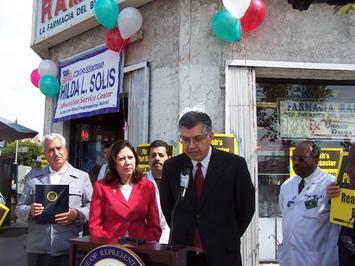
California’s 32nd congressional district, stretching from East Los Angeles to the eastern San Gabriel Valley, would seem like friendly territory for a Hispanic candidate. Labor Secretary-designate Hilda Solis’s district is more than 60 percent Latino, and there is no shortage of Hispanic local and state lawmakers eager to replace her in Congress.
But rapidly shifting demographics suggest an Asian-American candidate – State Board of Equalization Chairwoman Judy Chu – has a shot at winning the urban-suburban district. Asians make up nearly 20 percent of the district, whom statistics suggest are better-organized politically, wealthier and have generally attained a higher level of citizenship (voting power) than Latino residents.
The 32nd is one of several congressional districts that could soon trigger new leadership in ways that would have seemed unimaginable just a few years ago. The city where Chu long served as mayor, Monterey Park, is one of the only majority Asian-American municipalities in the nation.
The increasingly mobile nature of American society means that no district – no matter how carefully gerrymandered – can be considered permanently safe. So while Solis’s district could slip away, Latinos can look west down the I-10 freeway to a swath of potential pick-up opportunities among seats held by African-American lawmakers.
Consider the South Los Angeles-based 35th Congressional District, long represented by firebrand liberal Maxine Waters. The area won national attention – and infamy – as the epicenter of L.A.’s two postwar riots: in Watts in 1965 and at the corner of Florence and Normandie in 1992.
But the district is no longer majority black. Inglewood – once all white, later mostly black – is now about 46 percent Hispanic, though city statistics suggest African Americans still vote in higher numbers. Hawthorne now has more Hispanics than blacks. And South Los Angeles, an almost entirely black neighborhood at the time of the Watts riots, now is home to more Hispanics. A small shift in district boundaries in the post-2010 Census redistricting process could provide a Hispanic lawmaker a decent shot at beating Waters in a Democratic primary.
Rep. Diane Watson faces a similar political predicament in the neighboring 33rd District. Watson was a pioneering African-American lawmaker in her long state Senate career before serving as ambassador to Micronesia in the Clinton administration. She won a 2001 special election to Congress in the demographically diverse district, which begins about one mile inland from Venice Beach, runs through Culver City and ends up in South Los Angeles. The district also includes Koreatown, the Miracle Mile district, and Hollywood – all areas with both an influx of immigrants from various countries and a growing cadre of young professionals.
Though once solidly African-American, the district is now 35 percent Hispanic, 30 percent black and 12 percent Asian. Lower citizenship rates among Latinos have deflated their political clout. But small shifts in new redistricting could have a considerable impact on Watson, altering the district’s racial and ethnic balance of power and possibly generating serious primary competition from a Latino challenger.
This drama was already played out in the Long Beach area 37th Congressional District during a 2007 special election. The seat takes in Compton and Carson, which went from predominately black through the 1980s to heavily Latino. When Rep. Juanita Millender-McDonald passed away in early 2007 the open seat special election quickly came down to another African-American Assemblywoman – Laura Richardson – and Hispanic state senator Jenny Oropeza. Richardson edged out Oropeza in the special election primary, a temporary setback for Hispanic political ambitions. But the district could change considerably in redistricting within two years, providing another Hispanic pickup opportunity.
The story is similar in other demographically shifting districts around the nation. In 2008 once-Republican Virginia, Democrats took over three U.S. House seats. The suburban district of long-time Republican Rep. Tom Davis fell to Democrat Gerry Connolly in an area filled with professional transplants from across the Potomac in Washington, D.C. Though technically part of the South, Northern Virginia votes more like affluent parts of New Jersey.
Michigan, Pennsylvania and other large states with relatively static populations are projected to lose seats in the post-2010 redistricting process. Meanwhile rapidly growing Sunbelt states like Arizona, Florida and Texas will make big gains. All these states are seeing rapid demographic shifts, particularly from Latinos.
Members of Congress have grown expert in tailoring district lines to their own political advantage. But given the rapidly shifting demography of the nation, the redistricting process of 2011 could result in even the craftiest lawmakers and political consultants losing control of their electorate.
David Mark is a senior editor at Politico.com and author of Going Dirty: The Art of Negative Campaigning.












